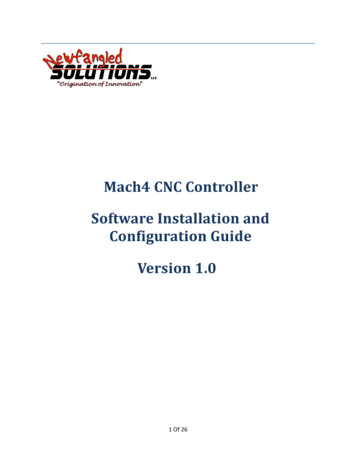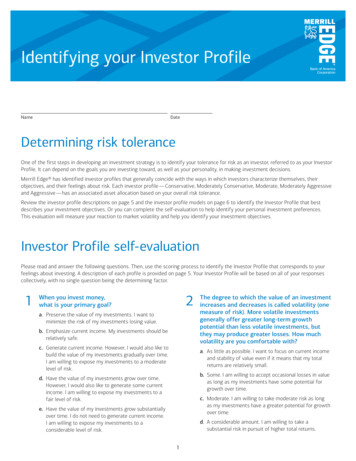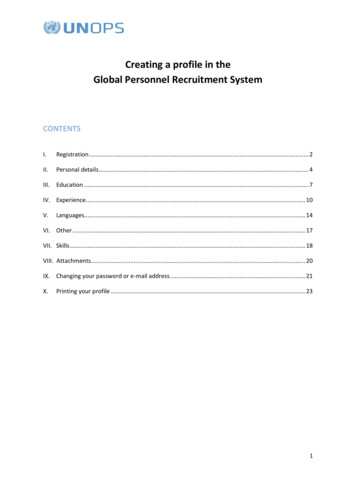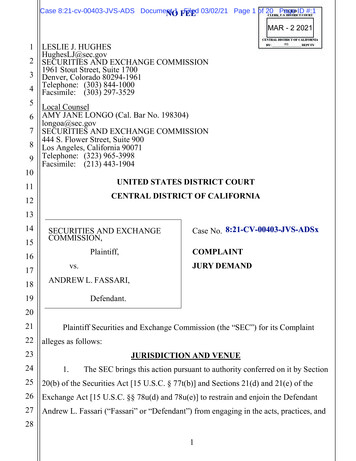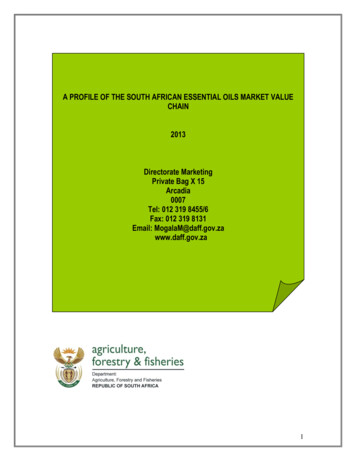
Transcription
A PROFILE OF THE SOUTH AFRICAN ESSENTIAL OILS MARKET VALUECHAIN2013Directorate MarketingPrivate Bag X 15Arcadia0007Tel: 012 319 8455/6Fax: 012 319 8131Email: MogalaM@daff.gov.zawww.daff.gov.za1
Table of Contents1. DESCRIPTION OF THE ESSENTIAL OILS’ INDUSTRY41.1 Production and Production Areas41.1.1 Overview of the essential oils market and its composition71.1.2 Identification of Products72. HARVESTING OF ESSENTIAL OILS72.1 Harvesting72.2 Essential Oils Marketing Activities73. EXPORTS VOLUMES84. SHARE ANALYSIS303.1 Share Analysis305. IMPORTS VOLUMES345. USES OF ESSENTIAL OILS436. QUALITY & MAINTANANCE OF ESSENTIAL OILS457. ESSENTIAL OIL VALUE CHAIN ANALYSIS468. ESSENTIAL OILS DISTRIBUTION CHANNELS518.1 Value Adding in South Africa529. MARKET ACCESS5310. MARKET INTELLIGENCE5811. THE ESSENTIAL OILS OF PEPPERMINT10211.1 Description of the herb peppermint10211.1.1 Properties of peppermint1022
11.1.2 Safety precautions and warnings10211.1.3 Production levels in South Africa10211.1.4 Major production Areas in South Africa10211.1.5 Stem, Leaves, and Flowers10311.1.6 Essential part of peppermint10311.1.7 Post harvest handling10311.1.8 The peppermint sale price10411.1.9 Essential Oils of Peppermint Industrial Utilization10411.1.10 Cosmetic Utilization10412. ACKNOWLEDGEMENTS1113
1. DESCRIPTION OF THE ESSENTIAL OILS’ INDUSTRYAn essential oil is a liquid that is generally distilled (most frequently by steam or water) from theleaves, stems, flowers, bark, roots, seeds, fruits or other organs of a plant. Using the differenttechnologies available essential oils are sourced from over 3,000 plants of which approximately300 are of commercial importance. Most flowers contain very little volatile oil and their chemicalcomponents are too delicate and easily denatured by the high heat used in steam distillation.A solvent such as hexane or supercritical carbon dioxide is used to extract the oils. Extracts fromhexane and other hydrophobic solvents are called concretes, which is a mixture of essential oil,waxes, resins, and other lipophilic (oil soluble) plant material. The majority of essential oils areusually obtained from agricultural plants but a number of oils are collected from wild sourcesincluding trees.The strengths of essential oils They are antibacterial, antiviral, antifungal, and antimicrobial.Essential oils by-pass the digestive system so they are beneficial for people with poordigestion/assimilation.They require no refrigeration and require very little storage space.They have the longest shelf life of any plant known to man.Essential oils are highly oxygenating.They are very cost-effective because they are one of the few substances that themore you use them, the less you need them.They are suitable for babies since they cannot swallow tablets and capsules thusessential oils provide a solution as they only come in liquid form.Weakness of the Essential Oils industry (Production Constraints) Production of essential oils requires highly focused farm practices and fieldmaintenance for high quality yield.Requires more technical support, including the production inputs and most effectiveplant material for new plantingsThere is a high entry barrier which includes fencing, cuttings, distillation plants and landpreparation.1.1 Production and Production AreasThe major producers of essential oils across the world are Brazil, China, USA, Egypt, India,Mexico, Guatemala, Morocco and Indonesia. All of them with the exception of USA are developingcountries with low cost, peasant type economies. It is estimated that about 65% of world productionemanates from developing countries. The major consumers are the USA (40%), Western Europe(30%) and Japan (7%). While the EU as a whole dominate world trade, exports and imports, noindividual country from this bloc features in the list of major producers.4
Most of the major producing countries have large populations with huge internal appetite foressential oils. The table below shows the projected hectares under essential oil crops given byprovinces in South Africa by 2012.Table 1 below shows the estimated hectares of essential oil crops of different species which will beplanted by different provinces by 2014.Table 1: The projected ha under essential oil crops by 2011 as given by Provinces.ProvinceMpumalangaFree StateSpeciesTOTAL haVetiver, Citronella, Lippia, Eucalyptus, Artemisia, Rosemary, 942Geranium, Lemon grassTagete, Artemisia, Lavendin71Northern CapeMarjoram, Rosemary, Lavendin44North WestEastern CapeGeranium, Rosemary, Lavendin, ChamomileGeranium, Rosemary, Lavender39220Western CapeEriocephalus, Lavender, Lavandin, Buchu, Rosemary78LimpopoMachadoGautengKZN& Lippia, Geranium, Rosemary, Lavendin, Tea tree92Lavendin, Rosemary, Artemisia83Lavendin, Rosemary Eucalyptus, Geranium, Tea tree, Lemon tea 425tree, Spear Mint, Lemon grass, Artemisia, Melissa, ThymeTOTALThese estimates exclude wild harvesting and community projects in progress1994Source: South African Essential Oil Producer Association (SAEOPA)The table shows that in the Mpumalanga province it is projected that 942 ha will be planted toessential oil crops by 2014, followed by KwaZulu Natal with 425 ha and Eastern Cape with 220 ha.The estimated total hectares to be devoted to essential oil crops by all the provinces by 2014 areabout 1994 ha. However of all the total species estimated, Geranium, Lavendin and Rosemary arethe most projected species to be planted in all provinces by 2014. The table further shows that inall Provinces, Mpumalanga and KwaZulu Natal Provinces are projected to be the major producersof most kinds of essential oil species than the other provinces by 2014.5
Table 2: Estimated Production Statistics for certain selected Essential Oils 2012.OIL TYPESESTIMATED VALUE OFPRIMARY PRODUCTION(2012)Major Oil (Citrus) and Eucalyptus)R7 444 526.00Minor Oils (e.g. Chamomiles, Jasmine, Lavenders, Tea R2 237 169.75Trees, Mints)Minor Oils-FRIDGE Study - SpecifiedGeranium (Pelargonium Graveolens Roseum)R541 666.67Buchu (Betulina, Crenulata)500 000.00Chamomile – Roman (Anthemis nobilis)R24 305.56Rosemary (Rosmarinus Officinalis)R15 000.00Lemon Grass (Cymbopogon Citratus)R7 777.78Lemon balm (Melissa officinalis)Lippia (Lippia javanica)Rose Damascene (Rosa Damascene)Source: Institute of Natural ResourcesTable 2 indicates different types of essential oils and the estimated values of primary production in2012 marketing season.Table 3: The most utilized essential oils and major producers during 2012ProductCountryOrangeCorn mintEucalyptus (cineole-type)CitronellaPeppermintLemonClove leafCedar woodLitsea cubebaSassafrasLimeSpearmintAustralia, Brazil, Dominican Republic, Israel, Italy and USABrazil, China, India, Japan, North Korea, Paraguay, Taiwanand ThailandAustralia, Austria, Brazil, China, India, Paraguay, Portugal,South Africa and SpainChina, India and VietnamAustralia, China, Italy, Japan and USAArgentina, Australia, Brazil, Greece, Spain, Italy, USA andPeruBrazil, Indonesia, Madagascar, Sri Lanka and TanzaniaUSA and ChinaChinaBrazil and USABrazil, China, Cuba, Ghana, Haiti, Ivory Coast, Jamaica,Mexico and PeruArgentina, Australia, Brazil, Bulgaria, China, Egypt, France,Hungary, Japan, Korea, Morocco, New Zealand, Paraguay,Romania, Russia, Taiwan, UK, USA and YugoslaviaSource: South African Essential Oil Producer Association (SAEOPA)Table 3 indicates the most utilized essential oil products and its major producers in south Africaduring 2012/13 marketing season.6
1.1.1 Overview of the essential oils market and its compositionProduction data for essential oils are hard to find, as it is very difficult to do an exhaustivecompilation covering the broad spectrum of all of essential oils produced. The essential oil industryis dynamic with tastes and preferences of consumers changing by the day. The top 10 crops interms of production account for about 80% of the total world market for essential oils. One of themost important things to do for farmers who want to be involved in essential oils production isselecting the right seed or plant material for sowing. It is recommended that this be obtained from areputable supplier. Farmers should also be knowledgeable on weed control and management asthis will affect the quality of the end product. If weeds are harvested and distilled with the crop, theoil from weeds can contaminate the desired oil, which would compromise quality. These would leadto a total rejection of the crop’s oil which will have a negative impact on the farm income.1.1.2 Identification of ProductsGiven the appropriate equipment, essential oils can be fractionated and components soldindividually. Alternatively, at home industry level, essential oils can be used in scented candles,soaps, and hand creams. Some authors are of the view that massaging oils into the human skin asin aromatherapy is of little therapeutic value, although it may induce a sense of sensual well being.However, in spite of the lack of a scientific basis for aromatherapy, it remains a viable componentof the market for the South African essential oils industry.There are numerous ways to create value added products through the use of essential oils.Based on information gathered from a brief overview of the essential oil sub sector map and valuechain, it has been decided that the following value added products will be investigated further,completing each investigation with a sub sector map for that product. The products are; Soaps,Scented candles, Bath salts, Aromatherapy creams and lotions and Potpourri.It has been determined that each of these identified products are relatively simple to make, thusmaking use of the home based production units, and have a viable market within South Africa, andparticularly, the Eastern Cape. Each of these products will be discussed in detail.2. HARVESTING OF ESSENTIAL OILS2.1 HarvestingIt must be noted that the essential oils can be harvested as either plants or seeds. For the plantsthe proximity of the steam distillation plant is important. If the period between harvesting anddistillation is too long the oil from the plant can evaporate or decline in quality. The quality of the oilis volatile. It changes as the crop grows; this means that a farmer should ensure that the crop isharvested at the right time.2.2 Essential Oils Marketing Activities7
The marketing structure of essential oils is not different from most products. The traditionalstructure begins with the producer who sells to the flavor and fragrance industries. Fragrancehouses may or may not embark on value adding to the product, they then sell it to the end users.At times system has been supplemented by traders, agents and brokers who use their knowledgeto market niches and buy directly from producers and sell directly to the flavor houses or endusers. Although it is very difficult to enter into the essential oils industry from either side, asproducers or end users, there is always an opportunity for small players. The reason for thedifficulty in gaining entry is that once end users have developed a product using specific oil they donot want to change that oil or the supplier as they may fear a compromise in quality. Small scalefarmers may enter the market and target small industries such as Aromatherapy and Massage fortheir product market.3. EXPORTS VOLUMESFigure 1 below indicates export volumes of essential oils (terpeneless or not), from South Africa tovarious regions between 2003 and 2012.Expprt Quantities (tons)Figure 1: Export volumes of essential oils (terpeneless or not) to 000Period (Years)Source: Quantec EasyDataThe figure further indicates that the major export markets for essential oils (terpeneless or not) fromSouth Africa to the world was Europe, followed by Africa. Americas, Oceania and Asia had verylow levels of exports of essential oils (terpeneless or not) during the same period under review. Thefigure also indicates that exports of essential oils (terpeneless or not) from South Africa to Europestarted to increase in 2003 and at the same time attained a peak at approximately 572 tons. Thefigure further indicates that exports of essential oils (terpeneless or not) from South Africa to Africa8
also started to increase in 2003 and at the same period attained a peak at approximately 245 tons.Figure 1 further indicates that the demand for essential oils (terpeneless or not) from South Africato Americas, Asia and Oceania was less as compared to what South Africa exported to Europe andAfrica during the period under review. The figure also indicates that exports of essential oils(terpeneless or not) from South Africa to Europe and Africa declined during the second half of theten year period to lower levels of about 1 ton per annum. The figure also indicates that there was a100% decline in exports of essential oils (terpeneless or not) from South Africa to Europe andAfrica in 2012 as compared to 2003.Figure 2 depicts export volumes of essential oils (terpeneless or not) from South Africa to Africabetween 2003 and 2012.Figure 2: Export volumes of essential oils (terpeneless or not) to AfricaExport Quantity 01020112012Eastern Africa Rest1810410538300Middle Africa Rest18101626000Western od (Years)Source: Quantec EasyDataThe graph further depicts that the major market for essential oils (terpeneless or not) from SouthAfrica to Africa was SADC, followed by low volumes of essential oils (terpeneless or not) toWestern Africa. The figure also depicts that exports of essential oils (terpeneless or not) fromSouth Africa to SADC were from a high base during the first half of the ten year period attaining apeak in 2006 at approximately 211 tons. The figure further depicts that exports volumes ofessential oils (terpeneless or not) from South Africa to Western Africa attained its peak in 2003 atapproximately 48 tons. Eastern Africa Rest and Middle Africa Rest had very low levels of exports ofessential oils (terpeneless or not) from South Africa of not more than 18 tons per annum during theperiod under review. The figure also depicts that the demand for essential oils (terpeneless or not)from South Africa to Western Africa, Middle Africa Rest, Eastern Africa and Northern Africa wasless as compared to what South Africa exported to SADC over the same period under examination.The figure further depicts that between 2011 and 2012 of the period under scrutiny, there were no9
export volumes of essential oils (terpeneless or not) from South Africa to SADC. In 2012, there wasa 100% decline in export volumes of essential oils (terpeneless or not) from South Africa to SADCas compared to 2003.Figure 3 below illustrates export volumes of essential oils (terpeneless or not) from South Africa toSADC member states between 2003 and 2012.Export Quantity (tons)Figure 3: Export volumes of essential oils (terpeneless or not) to SADC1401201008060402002003 2004 2005 2006 2007 2008 2009 2010 2011 2012Angola53731370000Democratic Republic of the 1825182615000Mozambique84631812226188100United Republic of 467108113100Period (Years)Source: Quantec EasyDataThe graph further illustrates that the major attractive market for essential oils (terpeneless or not)from South Africa to SADC was Mozambique, followed by Mauritius and Malawi over the pastdecade. The graph further illustrates that exports of essential oils (terpeneless or not) from SouthAfrica to Mozambique started to increase in 2003 and at the same time attained a peak atapproximately 84 tons. The figure also illustrates that the demand for essential oils (terpeneless ornot) from South Africa to Mozambique declined between 2004 and 2005 until another peak wasattained in 2006 at approximately 122 tons. The figure further illustrates that Mauritius attained apeak in 2008 at approximately 77 tons during the period under review. The figure also illustratesthat Malawi attained a peak in 2004 at approximately 48 tons during the period under review. SouthAfrica only exported very low volumes of essentials oils (terpeneless or not) to DemocraticRepublic of Congo and United Republic of Tanzania. In 2012, there was a 100% decline in exportvolumes of essential oils (terpeneless or not) from South Africa to Mozambique as compared to2011.10
Figure 4 below depicts export volumes of essential oils (terpeneless or not) from South Africa toAmericas between 2003 and 2012.Export Quantity (tons)Figure 4: Export volumes of essential oils (terpeneless or not) 07200820092010201120125275537163101500Period (Years)Source: Quantec EasyDataThe graph further depicts that the most attractive market for essential oils (terpeneless or not)exports from South Africa to Americas was NAFTA. The graph also depicts that essential oils(terpeneless or not) exports from South Africa to Americas started to increase in 2003 until a peakwas attained in 2004 at approximately 75 tons over the ten year period. Essential oils (terpenelessor not) exports from South Africa to NAFTA were from a very low base during the second half ofthe ten year period reaching not more than 15 tons during the period under scrutiny. The graphalso depicts that between 2011 and 2012 of the period under scrutiny, there were no essential oils(terpeneless or not) exports from South Africa to NAFTA. The figure further depicts that there was100% decline in export volumes of essential oils (terpeneless or not) from South Africa to NAFTAin 2012 as compared to 2011.Figure 5 below indicates export volumes of essential oils (terpeneless or not) from South Africa toAsia between 2003 and 2012.11
Figure 5: Export volumes of essential oils (terpeneless or not) to AsiaExport Quantity 01020112012South-central Asia051001701000South-eastern Asia0000014000Western Asia0111060000Period (Years)Source: Quantec EasyDataThe graph further indicates that the major export destination for essential oils (terpeneless or not)from South Africa to Asia was South-central Asia, followed very intermittent exports to Western andSouth-eastern Asia. The graph also indicates that exports of essential oils (terpeneless or not) fromSouth Africa to Western Asia and South-eastern Asia were below 7 tons per annum over the pastdecade. The graph further indicates that export volumes of essential oils (terpeneless or not) fromSouth Africa to South-central Asia started to increase in 2004 and 2005, and then a declineoccurred in 2006 to lower levels until a peak was attained in 2007 at approximately 17 tons. Thegraph further indicates that export volumes of essential oils (terpeneless or not) from South Africato South-central Asia were from a low base during the second half of the ten year period not morethan 1 ton per annum. In 2012, there was a 100% decline in export volumes of essential oils(terpeneless or not) from South Africa to South-central Asia as compared to 2004.Figure 6 below depicts export volumes of essential oils (terpeneless or not) from South Africa toEurope between 2003 and 2012.12
Figure 6: Export volumes of essential oils (terpeneless or not) to EuropeExport Quantity 009201020112012Western EuropeRest2222242100European Union57014617317216014016810100Period (Years)Source: Quantec EasyDataThe figure further depicts that the major export destination for essential oils (terpeneless or not)from South Africa to Europe went to the European Union. The figure also depicts that exports ofessential oils (terpeneless or not) from South Africa to Western Europe Rest were very muchintermittent, with no exports of essential oils (terpeneless or not) in 2011 and 2012. The figure alsodepicts that export volumes of essential oils (terpeneless or not) from South Africa to EuropeanUnion were from a high base during the first half of the ten year period (2003-2007) attaining apeak in 2003 at approximately 570 tons. The graph further depicts that export volumes of essentialoils (terpeneless or not) from South Africa to the European Union were very low and not more than180 tons per annum between 2004 and 2012 export season. The figure also depicts that in 2012,there was a 100% decline in export volumes of essential oils (terpeneless or not) from South Africato the European Union as compared to 2003.Figure 7 illustrates export volumes of essential oils (terpeneless or not) from South Africa to theEuropean Union between 2003 and 2012.13
Export Quantity (tons)Figure 7: Export volumes of essential oils (terpeneless or not) toEuropean 7935United Kingdom764631757400Netherlands2617896412600Period (Years)Source: Quantec EasyDataThe graph further illustrates that the major export destination for essential oils (terpeneless or not)from South Africa to the European Union was Germany, followed by Netherlands and France.Belgium, Spain and United Kingdom imported very low or intermittent levels of essential oils(terpeneless or not) exports from South Africa during the period under scrutiny of not more than80 tons per annum. The graph further illustrates that exports volumes of essential oils (terpenelessor not) from South Africa to Germany attained a peak in 2007 at approximately 107 tons,Netherlands attained its peak in 2003 at approximately 261 tons. In 2012, there was a 100%decline in export volumes of essential oils (terpeneless or not) from South Africa to Germany ascompared to 2003.Figure 8 below indicates export volumes of essential oils (terpeneless or not) from South Africa toOceania between 2003 and 2012.14
Figure 8: Export volumes of essential oils (terpeneless or not) toOceaniaExport Quantity (tons)1009080706050403020100Australia and New Zealand2003 2004 2005 2006 2007 2008 2009 2010 2011 201273759279616042000Period (Years)Source: Quantec EasyDataThe figure further indicates that exports of essential oils (nes) from South Africa to Oceania went toAustralia and New Zealand during the period under scrutiny. The figure also indicates that exportsof essential oils (nes) from South Africa to Australia and New Zealand started to increasesubstantially in 2003 and 2004, until a peak was attained in 2005 at approximately 92 tons. Thefigure further indicates that exports essential oils (nes) from South Africa to Australia and NewZealand were from a high base during the first half of the ten year period (2003-2007) attaining apeak in 2005. Between 2008 and 2012, exports of essential oils (nes) from South Africa toAustralia and New Zealand were from a low base during the second half of the ten year period(2008-2012) of not more than 60 tons per annum during the same period under examination. Thefigure also indicates that there was a 100% decline in export volumes of essential oils (terpenelessor not) from South Africa to Australia and New Zealand as compared to 2003.Figure 9 below shows export volumes of essential oils (terpeneless or not) from South Africa toAustralia and New Zealand between 2003 and 2012.15
Figure 9: Export volumes of essential oils (terpeneless or not) toAustralia and New ZealandExport Quantity 00620072008200920102011201273749179606042000Period (Years)Source: Quantec EasyDataThe figure further shows that exports of essential oils (nes) from South Africa to Australia and NewZealand went to Australia during the period under scrutiny. The figure also shows that exports ofessential oils (nes) from South Africa to Australia started to increase substantially in 2003 and2004, until a peak was attained in 2005 at approximately 91 tons. The figure further shows thatexports essential oils (nes) from South Africa to Australia were from a high base during the first halfof the ten year period (2003-2007) attaining a peak in 2005. Between 2008 and 2012, exports ofessential oils (nes) from South Africa to Australia were from a low base during the second half ofthe ten year period (2008-2012) of not more than 60 tons per annum during the same period underexamination. The figure also shows that there was a 100% decline in export volumes of essentialoils (terpeneless or not) from South Africa to Australia in 2012 as compared to 2003.Figure10 below depicts values of essential oils (terpeneless or not) exports by provinces of SouthAfrica to the world between 2003 and 2012.16
Figure 10: Value of essential oils (terpeneless or not) exports by ProvincesExport Value 52006200720082009201020112012Western 1543694065519319753869121842736777Eastern 750118870453199764Northern Cape076700000000000Free North 7143621813498Period (Years)Source: Quantec EasyData17
The figure further depicts that the major supplying market for essential oils (terpeneless or not)from South Africa to the world was Gauteng Province, followed by Western Cape and North WestProvinces during the period under scrutiny. The figure also depicts that exports of essential oils(terpeneless or not) by Gauteng province to the world were from a low base during the first half ofthe ten year period (2003-2007) attaining higher levels of about R55.6 million in 2005. Exports ofessential oils (terpeneless or not) by Gauteng province to the world were from a high base duringthe second half of the ten year period (2008-2012) attaining higher levels and a peak in 2008 and2010 of about R77.1 and 77.9 million respectively. Exports of essential oils (terpeneless or not)from the world Western Cape Province to the world attained a peak in 2008 at approximately R86.6million, while North West Province attained a peak in 2003 at approximately R27.4 million. EasternCape, Free State, KwaZulu Natal, Northern Cape, Mpumalanga and Limpopo provinces had verylow export volumes of essential oils (terpeneless or not) to the world during the period underexamination of not more than R25 million per annum. The figure further depicts that in 2012, therewas a 33.2% decline in exports value of essential oils (terpeneless or not) from Gauteng Provinceto the world as compared to 2011, while there was a 10.6% increase in exports value of essentialoils (terpeneless or not) from the Western Cape Province to the world as compared to 2011.Figure 11 below indicates export values of essential oils (terpeneless or not) from GautengProvince to the world between 2003 and 2012.18
Figure 11: Value of essential oils (terpeneless or not) exports by Gauteng ProvinceExport Value 0000020000000100000000Sedibeng District municipalityMetsweding District 0000692015013000West Rand District 68439121566097863Ekurhuleni Metropolitan 7120690910915478715171062702City of Johannesburg Metropolitan Municipality 35476807 35279114 47505040 26008026 37276874 63708447 35575664 57887212 69970174 40155294City of Tshwane Metropolitan 42231 14922607 12480239 17323381 14046093Period (Years)Source: Quantec EasyData19
The figure further indicates that the major supplying market for essential oils (terpeneless or not)from Gauteng Province to the world was the City of Johannesburg Metro Municipality, followed bythe City of Tshwane Metro Municipality and West Rand District Municipality during the period underscrutiny. The figure also indicates that exports of essential oils (terpeneless or not) by the City ofJohannesburg Metro Municipality to the world were from a low base during the first half of the tenyear period (2003-2007) attaining higher levels of about R47.5 million in 2005. Exports of essentialoils (terpeneless or not) by the City of Johannesburg Metro Municipality to the world were from ahigh base during the second half of the ten year period (2008-2012) attaining higher levels and apeak in 2008 and 2010 of about R63.7 and 69.9 million respectively. Exports of essential oils(terpeneless or not) from the City of Tshwane Metro Municipality to the world attained a peak in2011 at approximately R17.3 million during the period under review. Sedibeng, Metsweding DistrictMunicipalities and Ekurhuleni Metro Municipality had very low export volumes of essential oils(terpeneless or not) to the world during the period under examination of not more than R7.0 millionper annum. The figure further depicts that in 2012, there was a 33.2% decline in exports value ofessential oils (terpeneless or not) from Gauteng Province to the world as compared to 2011, whilethere was a 10.6% increase in exports value of essential oils (terpeneless or not) from the WesternCape Province to the world as compared to 2011.Figure 12 shows export values of essential oils (terpe
The table below shows the projected hectares under essential oil crops given by provinces in South Africa by 2012. Table 1 below shows the estimated hectares of essential oil crops of different species which will be planted by different provinces by 2014. Table 1: The projected ha under essential oil crops by 2011 as given by Provinces.


